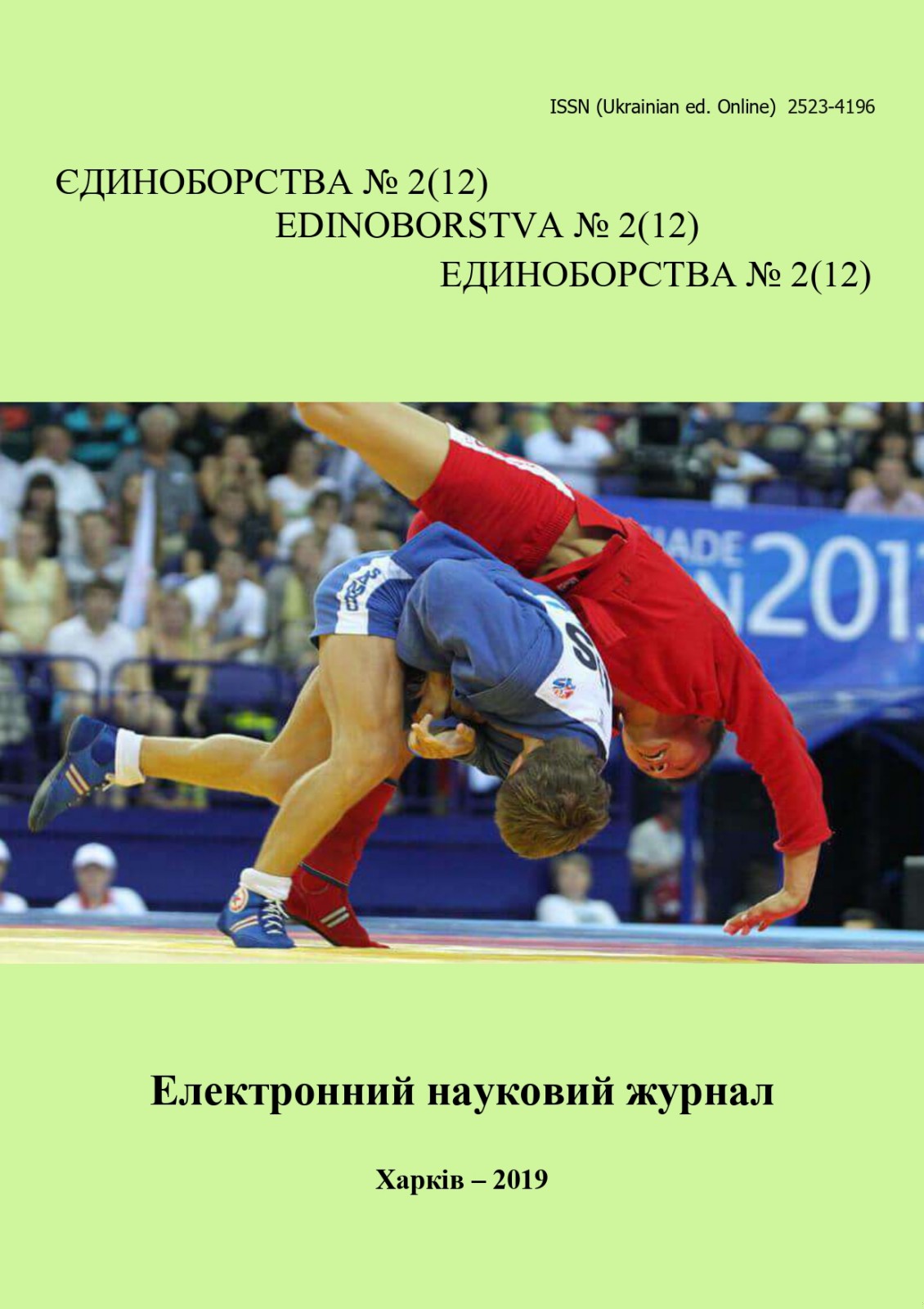Individual styles of combat activities of young fencers
Keywords:
fencing, epee fencers, combat activities, combat, sportAbstract
Purpose: to explore the method of forming an individual style of conducting combat activities among young fencers. Material and methods: 23 women aged 12–13 years took part in the study. The study lasted 10 months. Athletes trained 3-4 times a week for 90 minutes. The analysis of the special literature, pedagogical observations, interviews of the coach, parents and athletes, the psychological and pedagogical characteristics of each fencer were made. Evaluation of the proposed methodology was carried out by analyzing the dynamics of changes in the performance indicators of combat operations, which were determined by each of the epee attackers during competitive and training battles. At the beginning and at the end of the experiment, 115 fights were analyzed. Results. Based on the analysis of literary sources, the author developed a method for the formation of the individual style of the combat activities of young epee fencers; substantiated its introduction into the practice of the training process of the fencers; The data on the individual style of fighting by epee fencer of 12-13 years old is added. Taking into account the predominance of effective actions (actual touches), the epee fencers were divided into three conditional groups: predominantly attacker, predominantly defensive and mixed (combined) styles. The dynamics of changes in combat performance indicators proves the effectiveness of the implemented special exercises. Conclusions: the proposed method of preparing young fencers for competitions, taking into account their physical and psychological characteristics, as well as the formation of an individual manner of warfare, makes it possible to quickly form combat skills. A significant difference was established between the indicators of each comparison group, in the dynamics of the study (p <0.05) and a significant difference between the indicators of each of the comparison groups, in the dynamics of the study (p <0.01,) in the direction of decreasing the performance of random touches by the fencers.
References
Антохин, А. В. (2006). Построение интегральной подготовки фехтовальщиков-рапиристов 15-16 лет. (Автореф. дис. канд. пед.наук). Москва.
Бойченко, Н. В. (2007). «Пути повышения эффективности тренировочного процесса в восточных единоборствах». Физическое воспитание студентов творческих специальностей, 2, 148-150.
Бойченко, Н. В., Алексєнко, Я. В., & Алексєєва, І. А. (2015). Інноваційні технології в системі підготовки спортсменів-єдиноборців. Единоборства, (11), 25-27.
Бріскін, Ю. А., Задорожна, О. Р., & Пітин, М. П. (2018). Інноваційні засоби підготовки спортсменів у фехтуванні: монографія. Київ.
Бусол, В., & Дьоміна, О. (2013). Фехтування в Україні: історія та сучасний стан: навч. посіб. Київ.
Коробейніков, Г. В., & Дуднік О. К. (2006). «Діагностика психоемоційних станів у спортсменів». Спорт. медицина, 1, 33-36.
Кривенцова, И. В., Клименченко, В. Г., & Одокиенко, И. И. (2011). «Особенности методики обучения фехтованию будущих педагогов». ТМФВ, (11), 14-18.
Кривенцова, І. В., & Пашкевич, С. А. (2016). «Ефективність рухливих ігор у розвитку швидкісних якостей 12-14 річних фехтувальників». Наука і освіта, (8), 98-100.
Павлов, А. И. Павлович, В. Ю., & Лыков, Ю. В. (2011). «Специализированная подготовка к боям с конкретным соперником в фехтовании». Научно-методические проблемы спортивного фехтования: материалы науч.- практ. конф, Смоленская гос. акад. физ. культуры, спорта и туризма, 11-17.
Платонов, В. Н. (2015). Система подготовки спортсменов в олимпийском спорте. Общая те- ория и ее практические приложения : учебник [для тренеров] : 2 кн. Олимп. лит., Киев.
Ivashchenko, O. V., Iermakov, S. S., Khudolii, O. M., Cretu, M., & Potop, V. (2017). «Level of physical exercises’ mastering in structure of 11-13 yrs age boys’ motor fitness». Pedagogics, psychology, medical-biological problems of physical training and sports, 21(5), 236-243.
Korobeynikov, G., Korobeynikova, L., Iermakov, S., & Nosko, M. (2016). «Reaction of heart rate regulation to extreme sport activity in elite athletes». Journal of Physical Education and Sport, vol. 16, no. 3, pp. 976-981; doi: 10.7752/ jpes.2016.03154
Kozina, Zh. L., Kot, V., & Ogar, G. .A. (2018). «Individual approach in the preparation of athletes in martial arts». Health, sport, rehabilitation, 4(2), 28-38.
Kriventsova, I., Iermakov, S., Bartik, P., Nosko, M., & Wojciech J Cynarski. (2017). «Optimization of student-fencers’ tactical training». Ido Movement for Culture. Journal of Martial Arts Anthropology, 17(3), 21-30.
Tyshler, D. A., & Ryzhkova, L. G. (2014). «Pedagogic principles of initial training». Fizicheskaia kul’tura: vospitanie, obrazovanie, trenirovka, 3, 34-36.













